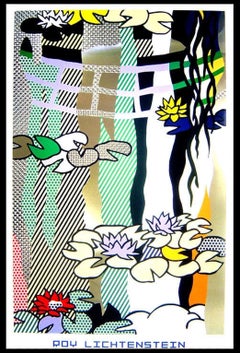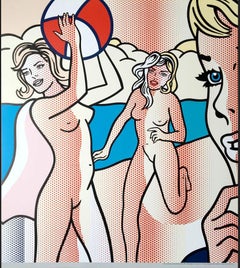Roy Lichtenstein Waterlilies
Recent Sales
1990s Abstract Prints and Multiples
Color
Late 20th Century Pop Art Prints and Multiples
Lithograph, Woodcut
Late 20th Century Pop Art Prints and Multiples
Lithograph, Woodcut
Late 20th Century Pop Art Prints and Multiples
Lithograph, Offset
Late 20th Century Pop Art Prints and Multiples
Lithograph, Offset
Late 20th Century Pop Art Prints and Multiples
Lithograph, Offset
Late 20th Century Pop Art Prints and Multiples
Lithograph, Offset
1990s Abstract Prints and Multiples
Color
1990s Abstract Prints and Multiples
Color
Late 20th Century Pop Art Prints and Multiples
Woodcut
Finding the Right Prints-works-on-paper for You
Decorating with fine art prints — whether they’re figurative prints, abstract prints or another variety — has always been a practical way of bringing a space to life as well as bringing works by an artist you love into your home.
Pursued in the 1960s and ’70s, largely by Pop artists drawn to its associations with mass production, advertising, packaging and seriality, as well as those challenging the primacy of the Abstract Expressionist brushstroke, printmaking was embraced in the 1980s by painters and conceptual artists ranging from David Salle and Elizabeth Murray to Adrian Piper and Sherrie Levine.
Printmaking is the transfer of an image from one surface to another. An artist takes a material like stone, metal, wood or wax, carves, incises, draws or otherwise marks it with an image, inks or paints it and then transfers the image to a piece of paper or other material.
Fine art prints are frequently confused with their more commercial counterparts. After all, our closest connection to the printed image is through mass-produced newspapers, magazines and books, and many people don’t realize that even though prints are editions, they start with an original image created by an artist with the intent of reproducing it in a small batch. Fine art prints are created in strictly limited editions — 20 or 30 or maybe 50 — and are always based on an image created specifically to be made into an edition.
Many people think of revered Dutch artist Rembrandt as a painter but may not know that he was a printmaker as well. His prints have been preserved in time along with the work of other celebrated printmakers such as Pablo Picasso, Salvador Dalí and Andy Warhol. These fine art prints are still highly sought after by collectors.
“It’s another tool in the artist’s toolbox, just like painting or sculpture or anything else that an artist uses in the service of mark making or expressing him- or herself,” says International Fine Print Dealers Association (IFPDA) vice president Betsy Senior, of New York’s Betsy Senior Fine Art, Inc.
Because artist’s editions tend to be more affordable and available than his or her unique works, they’re more accessible and can be a great opportunity to bring a variety of colors, textures and shapes into a space.
For tight corners, select small fine art prints as opposed to the oversized bold piece you’ll hang as a focal point in the dining area. But be careful not to choose something that is too big for your space. And feel free to lean into it if need be — not every work needs picture-hanging hooks. Leaning a larger fine art print against the wall behind a bookcase can add a stylish installation-type dynamic to your living room. (Read more about how to arrange wall art here.)
Find fine art prints for sale on 1stDibs today.
- Where is Roy Lichtenstein from?1 Answer1stDibs ExpertMarch 22, 2022Roy Lichtenstein is from New York City, New York. He was born in Manhattan on October 27, 1923, and he died in the city on September 29, 1997. Lichtenstein attended Ohio State University in Columbus, Ohio. On 1stDibs, find a range of Roy Lichtenstein art.
- Who is Roy Lichtenstein?1 Answer1stDibs ExpertMarch 22, 2022Roy Lichtenstein is an American artist who helped to shape the Pop art movement. He was born on October 27, 1923 in New York City, and he died there on September 29, 1997. Some of his most famous works include Whaam!, Drowning Girl and two different pieces titled Crying Girl. On 1stDibs, find a selection of Roy Lichtenstein art.
- 1stDibs ExpertMarch 22, 2022To pronounce Roy Lichtenstein, say, "Roy LICK-ton-stine." The artist's last name is of German origin. He was a leader of the Pop art movement who lived from 1923 to 1997. On 1stDibs, you can shop a variety of Roy Lichtenstein art.
- 1stDibs ExpertMarch 22, 2022Roy Lichtenstein influenced a number of contemporary artists, including Richard Bell, Grégoire Guillemin and Douglas Coupland. During his lifetime, he also inspired other Pop art artists like Andy Warhol, James Rosenquist and Claes Oldenburg. Shop a variety of Roy Lichtenstein art on 1stDibs.
- 1stDibs ExpertApril 5, 2022To authenticate Roy Lichtenstein art, consult the help of a licensed art appraiser with experience identifying Pop art. Due to the number of high quality giclée prints available, it is very difficult to verify that an artwork is real and not a reproduction. Shop a collection of expertly vetted Roy Lichtenstein art on 1stDibs.
- What inspired Roy Lichtenstein?1 Answer1stDibs ExpertMarch 22, 2022Advertising and comic books inspired Roy Lichtenstein to create art. In fact, many of his pieces appropriated images from these sources, transforming them into commentaries on geopolitics and social issues. On 1stDibs, you can shop a collection of Roy Lichtenstein art.
- Why was Roy Lichtenstein famous?1 Answer1stDibs ExpertApril 5, 2022Roy Lichtenstein was famous for his remarkable work in pop art, perhaps most notably, his comic book-style paintings. His work is renowned for its sense of parody. Shop a collection of Roy Lichtenstein pieces and prints from top sellers around the world on 1stDibs.
- 1stDibs ExpertMarch 22, 2022Roy Lichtenstein was important to the art world because he helped pioneer Pop art. This movement focused on incorporating images from pop culture and mass media into fine art. His work continues to influence contemporary artists like Richard Bell and Grégoire Guillemin to this day. Shop a collection of Roy Lichtenstein art on 1stDibs.
- 1stDibs ExpertApril 5, 2022Yes, Roy Lichtenstein did indeed use appropriation in his art. In this case, ‘appropriation’ in art is the use of existing objects or images with little or no transformation applied to them. One of Lichtenstein’s most famous pieces is ‘Look Mickey’ featuring Mickey Mouse and Donald Duck. Shop a selection of Roy Lichtenstein’s pieces from some of the world’s top art dealers on 1stDibs.
- 1stDibs ExpertMarch 22, 2022Roy Lichtenstein used patterns of dots to give his Pop art paintings the look of mass-printed graphics. To create this effect, he placed a stencil covered with perforated dots and brushed paint over the back. On 1stDibs, shop a collection of Roy Lichtenstein art.
- 1stDibs ExpertJune 6, 2024Roy Lichtenstein's art style was Pop art. In fact, he is one of the principal figures of the American Pop art movement, along with Andy Warhol, James Rosenquist, Claes Oldenburg and Robert Rauschenberg. Drawing inspiration from comic strips, Lichtenstein appropriated techniques of commercial printing in his paintings, introducing a vernacular sensibility to contemporary art. He employed visual elements such as the halftone dots that comprise a printed image and a comic-inspired use of primary colors to give his paintings their signature "Pop" palette. On 1stDibs, shop a selection of Roy Lichtenstein art.
- Is Roy Lichtenstein still alive?1 Answer1stDibs ExpertFebruary 22, 2021No, Pop artist Roy Lichtenstein is not alive. He died at the age of 73 in 1997. You can find Roy Lichtenstein's art on 1stDibs.
- 1stDibs ExpertMarch 22, 2022Roy Lichtenstein has a large number of famous paintings. The most famous include Whaam!, Drowning Girl, Look Mickey, M-Maybe, In the Car, Masterpiece, Crak!, and two separate works titled Crying Girl. You'll find a selection of Roy Lichtenstein art on 1stDibs.
- 1stDibs ExpertApril 5, 2024Roy Lichtenstein made his art by using comic books and advertisements as sources. He took images from pop culture and then painted them using Magna acrylic paints that had a flat finish that mimicked the look of printing inks. The Pop artist worked mostly in primary colors and employed thick lines and Ben-Day dots to give his work a cartoon-like quality. Shop a selection of Roy Lichtenstein art on 1stDibs.
- 1stDibs ExpertMarch 22, 2022Roy Lichtenstein studied art at Ohio State University. He received both Bachelor and Master of Fine Arts degrees from the university. For 10 years, he worked as an instructor at the institution. Find a range of Roy Lichtenstein art on 1stDibs.
- 1stDibs ExpertMarch 22, 2022No, Roy Lichtenstein did not paint Wonder Woman. However, other artists depicted the character in his style. Lichtenstein did use comic books for inspiration. For example, the 1962 issue of “All-American Men of War” from DC Comics was the source for his painting Whaam! Find a collection of Roy Lichtenstein art on 1stDibs.
- 1stDibs ExpertMarch 22, 2022Roy Lichtenstein used a number of materials in his artwork. For his paintings, Lichtenstein employed oil and acrylic paints, and often created stencils to guide his linework in order to give his images a printed quality. He also produced mixed media collages and sculptures. Find a selection of Roy Lichtenstein art on 1stDibs.
- 1stDibs ExpertAugust 26, 2024The difference between Andy Warhol and Roy Lichtenstein is what inspired their art. While both artists were leading figures in the Pop art movement, they produced different types of work. Lichtenstein is famous for drawing inspiration from comic books and appropriating techniques of commercial printing in his paintings. Andy Warhol tended to produce paintings and prints depicting celebrities, such as Marilyn Monroe, and everyday objects like Campbell's soup cans. On 1stDibs, shop a variety of Pop art.
- 1stDibs ExpertMarch 22, 2022Roy Lichtenstein was a part of the Pop art movement. He and other pop artists like Andy Warhol and James Rosenquist elevated images from pop culture and mass media into fine art as a way of commenting on geopolitical and social issues. You'll find a variety of Roy Lichtenstein art on 1stDibs.
- 1stDibs ExpertMarch 22, 2022Roy Lichtenstein painted Pop art to comment on geopolitical and social issues of his time. He patterned his work off of mass media like advertising and comic books to help convey his messages. On 1stDibs, shop a range of Roy Lichtenstein art.
Read More
10 Reasons Art Collectors Are Obsessed with Andy Warhol
More than three decades after his death, the prolific Pop artist and cultural icon's body of work continues to captivate. Here's a primer of some of his most notable motifs and mediums.
Exploring Our Current Obsession with Sixties Style
A new exhibition in Philadelphia stars a complex decade that continues to inspire.

